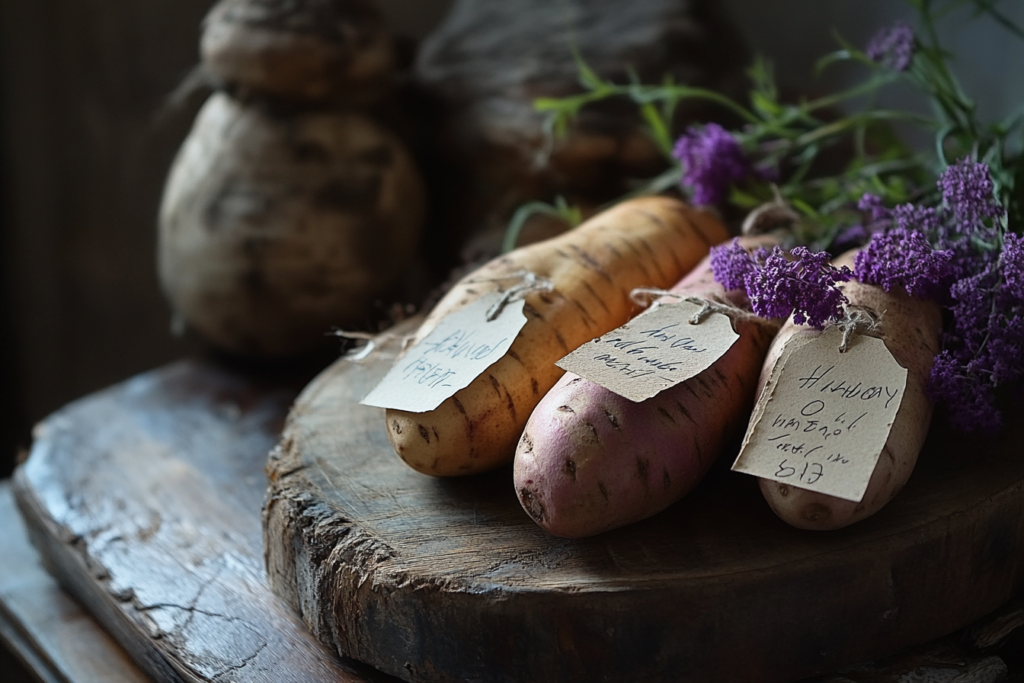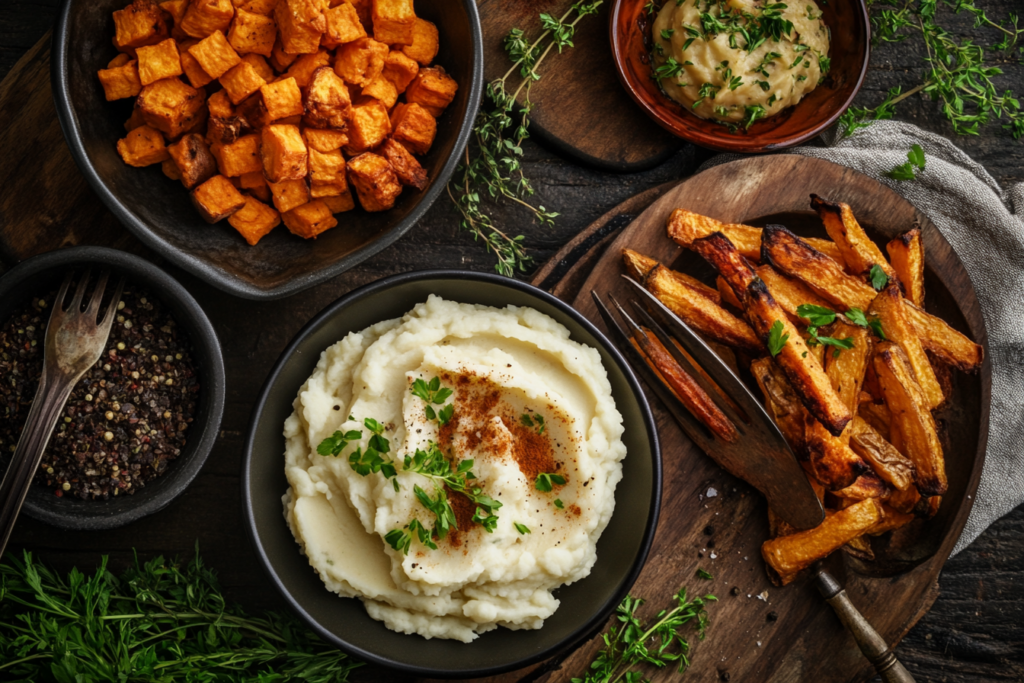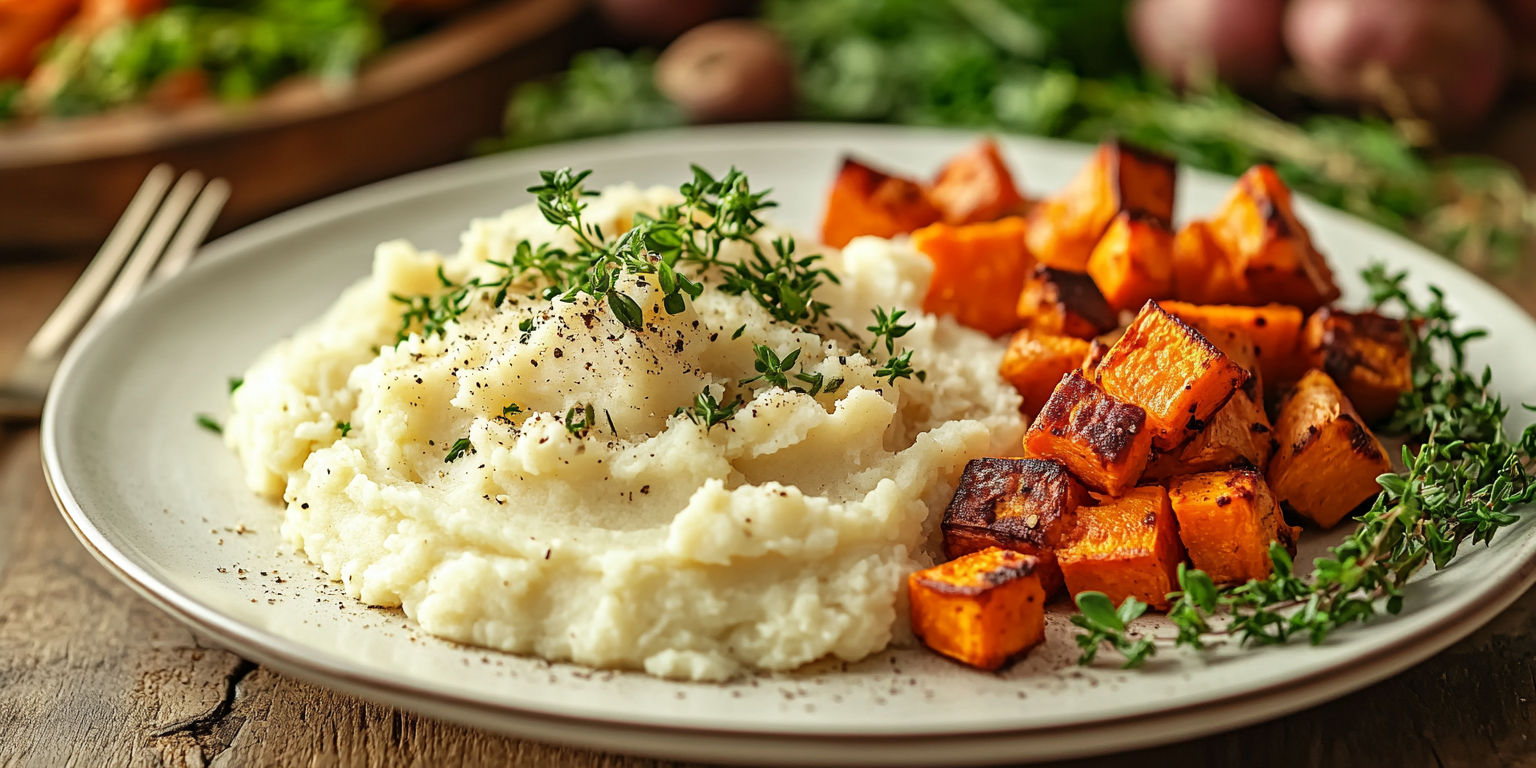White sweet potatoes might not be the most famous vegetable on your grocery list, but they are truly a hidden gem. So, what is a white sweet potato? It’s a versatile, mildly sweet, and nutrition-packed alternative to the more popular orange variety. Often overshadowed by its vibrant cousin, the white sweet potato offers a unique flavor and texture that make it perfect for a variety of dishes. Let’s dig in and explore everything there is to know about this delightful tuber.
Table of contents
Types of White Sweet Potato
Common Varieties Around the World

White sweet potatoes come in several varieties, each with subtle differences in taste and texture. Some of the most common types include:
- Hannah Sweet Potatoes: These are creamy and slightly nutty in flavor, with a dry texture.
- Japanese White Sweet Potatoes: Slightly firmer, with a nuttier taste.
- O’Henry Sweet Potatoes: A sweeter and moister variety, perfect for baking.
Each type has its charm, so don’t be afraid to experiment with them in your kitchen!
How White Sweet Potatoes Differ from Orange Varieties
Let’s face it—orange sweet potatoes are the poster child of sweet potato fame. They’re sweeter, moister, and more vibrant, which makes them popular for desserts or dishes that call for natural sweetness. In contrast, white sweet potatoes are subtler in both taste and texture. Their mild flavor allows them to shine in savory recipes, where you want the ingredients to speak for themselves.
Nutritional Profile of White Sweet Potatoes
When it comes to nutrition, white sweet potatoes are no slouch. They may not be as vibrant as their orange counterparts, but they still pack a punch in terms of vitamins, minerals, and health benefits.
| Nutrition Facts (Per 100g) | Amount |
|---|---|
| Calories | 86 kcal |
| Carbohydrates | 20 g |
| Protein | 1.6 g |
| Fiber | 3 g |
| Vitamin C | 12 mg (20% DV) |
| Potassium | 337 mg (10% DV) |
| Vitamin B6 | 0.2 mg (10% DV) |
Macronutrient Composition
White sweet potatoes are an excellent source of complex carbohydrates, making them a great energy booster. They’re also rich in dietary fiber, which promotes digestive health and keeps you feeling full longer. With minimal fat and a modest amount of protein, they fit perfectly into a balanced diet.
Key Vitamins and Minerals
These tubers are loaded with essential nutrients like Vitamin C, potassium, and Vitamin B6. While they don’t have the same level of beta-carotene as orange sweet potatoes, they still contribute to your daily dose of antioxidants and immunity-boosting vitamins.
Health Benefits of White Sweet Potatoes
Why should you add white sweet potatoes to your diet? For starters, their high fiber content aids digestion and prevents constipation. They’re also a great source of potassium, which helps regulate blood pressure and supports heart health. If you’re someone who watches their blood sugar levels, white sweet potatoes are a fantastic choice thanks to their low glycemic index.
Culinary Uses of White Sweet Potatoes
Popular Dishes Featuring White Sweet Potatoes

The versatility of white sweet potatoes is unmatched. You can bake, boil, mash, fry, or roast them. They work well in soups, stews, casseroles, and even desserts! Some popular dishes include:
- White sweet potato fries: A healthier alternative to regular fries.
- Mashed white sweet potatoes: Creamy and comforting, perfect for Thanksgiving.
- White sweet potato salad: A unique twist on the classic potato salad.
Tips for Cooking White Sweet Potatoes
Cooking white sweet potatoes is easy, but a few tips can help you get the best flavor and texture:

- Roast them: Roasting enhances their natural sweetness and creates a crispy exterior.
- Season generously: Their mild flavor pairs well with bold spices like paprika, cumin, and cinnamon.
- Pair with fats: A drizzle of olive oil or a pat of butter brings out their creamy texture.
White Sweet Potatoes vs Other Root Vegetables
White sweet potatoes often get lumped together with other root vegetables, but they deserve their own spotlight. Let’s compare them to similar veggies to see how they stack up.
Comparing White Sweet Potatoes to Yams
First off, let’s clear up a common misconception: white sweet potatoes and yams are not the same thing. Yams are starchy tubers with rough, scaly skin, and they’re more common in African and Caribbean cuisine. They have a much drier texture and a more neutral taste compared to the mild sweetness of white sweet potatoes. While yams are great for hearty stews, white sweet potatoes are more versatile and easier to prepare.
White Sweet Potatoes vs Regular Potatoes
Think of white sweet potatoes as the middle ground between regular potatoes and orange sweet potatoes. Regular white potatoes are starchier and less sweet, making them ideal for dishes like fries or mashed potatoes. However, white sweet potatoes bring a subtle sweetness and extra fiber, giving them an edge when it comes to nutrition. Plus, they’re lower on the glycemic index, making them a better choice for managing blood sugar.
Growing White Sweet Potatoes
Ever wondered if you could grow white sweet potatoes in your backyard? Good news—they’re not too fussy, and with a little know-how, you can cultivate your own crop!
Ideal Growing Conditions
White sweet potatoes thrive in warm, sunny climates with well-drained soil. They’re heat-loving plants, so they need plenty of sunshine—at least 6-8 hours a day. The soil should be loose and sandy, allowing the tubers to grow freely without resistance. If you live in a cooler region, don’t worry! You can grow them in containers or greenhouses to mimic their ideal environment.
Planting and Harvesting Techniques
Growing white sweet potatoes starts with slips—these are sprouts grown from mature sweet potatoes. Here’s a quick guide:
- Start with slips: Place a white sweet potato in water until sprouts appear, then plant the slips in soil.
- Space them out: Plant slips 12-18 inches apart to give the tubers room to grow.
- Water wisely: Keep the soil consistently moist, especially during the early stages.
Harvesting is a fun process! After about 90-120 days, the leaves will start to yellow—a sign that the tubers are ready. Gently dig them up, being careful not to bruise their delicate skin.
Common Pests and Diseases
Like any crop, white sweet potatoes are susceptible to pests and diseases. Keep an eye out for:
- Sweet potato weevils: Tiny insects that bore into the tubers.
- Fungal diseases: Such as leaf spots or root rot, which can damage your harvest.
Regularly inspect your plants and use organic solutions like neem oil to keep pests at bay.
Storage and Shelf Life of White Sweet Potatoes
Once you’ve harvested or bought white sweet potatoes, proper storage is key to maintaining their quality and flavor.
Best Practices for Storage
White sweet potatoes are sensitive to extreme temperatures. Follow these tips for optimal storage:
- Keep them cool and dry: Store them in a dark, well-ventilated space at 55-60°F (13-16°C).
- Avoid refrigeration: Cold temperatures can alter their texture and flavor, making them taste unpleasantly sweet.
- Handle with care: White sweet potatoes bruise easily, so avoid stacking them too high.
Stored correctly, they can last for up to two weeks. For longer storage, consider freezing cooked white sweet potatoes or drying them into chips.
Signs of Spoilage to Watch Out For
Not sure if your white sweet potatoes are still good? Look for these warning signs:
- Soft spots: A sure sign that the tuber is starting to rot.
- Wrinkled skin: Indicates dehydration and loss of quality.
- Mold or discoloration: A clear sign it’s time to toss them out.
By checking for these signs, you can ensure that your white sweet potatoes are always fresh and ready to use.
Recipe Article You Might Like
If you’re looking for creative ways to incorporate white sweet potatoes into your meals, check out these 10 Easy and Delicious Ways to Enjoy White Sweet Potatoes, which highlight their versatility in a variety of recipes. If you’re also curious about whether white sweet potatoes remain a healthy option, be sure to read our article White Sweet Potato Health Benefits for a detailed look into their nutritional advantages
For those interested in comparing different types of root vegetables, the guide on Baked Potato with Scrambled Eggs provides a unique twist on using starchy vegetables like potatoes. Additionally, if you’re curious about expanding your root vegetable knowledge, the post on Dense Bean Salad’s Nutrition Benefits and Culinary Uses offers complementary insights on healthy and diverse meal planning.
Conclusion
White sweet potatoes may not be as well-known as their orange cousins, but they’re undoubtedly a powerhouse in the kitchen and a nutrition-packed addition to any meal. Their subtle sweetness, versatile nature, and unique texture make them the perfect ingredient for both savory and sweet recipes. Whether you’re roasting, mashing, or frying them, white sweet potatoes are a delightful alternative to regular potatoes and other root vegetables.
Not only are they easy to cook, but they also bring an impressive range of health benefits to the table. From being diabetic-friendly to offering a good dose of fiber and essential nutrients, white sweet potatoes are a smart choice for anyone looking to eat healthier. Plus, their long storage life and ability to grow in a variety of conditions make them accessible to home gardeners and shoppers alike.
So the next time you’re at the grocery store, why not grab a few white sweet potatoes? Try experimenting with new recipes, and discover how this understated tuber can transform your meals. Once you taste their delicate flavor and enjoy their nutritional perks, you’ll wonder why they haven’t been a staple in your kitchen all along.
FAQs about White Sweet Potatoes
White sweet potatoes can spark a lot of curiosity. Let’s answer some of the most common questions!
What is the difference between white sweet potatoes and regular sweet potatoes?
White sweet potatoes and regular sweet potatoes differ in color, flavor, and texture. Regular sweet potatoes have vibrant orange flesh with a naturally sweet taste, while white sweet potatoes are cream-colored with a milder sweetness. White sweet potatoes are starchier and drier, whereas orange ones are moist and soft. Nutritionally, orange sweet potatoes are richer in beta-carotene, a powerful antioxidant, while white sweet potatoes are slightly lower in calories and sugar, making them a versatile option for savory dishes.
Are white sweet potatoes still healthy?
Yes, white sweet potatoes are very healthy. They’re rich in fiber, supporting digestion and gut health, and provide essential vitamins like Vitamin C and B6, along with potassium and magnesium. While they contain less beta-carotene than orange varieties, they still offer antioxidants and have a lower glycemic index, making them suitable for people managing blood sugar levels. They’re an excellent addition to a balanced diet.
Which color sweet potato is healthiest?
The “healthiest” sweet potato depends on your nutritional goals. Orange sweet potatoes are high in beta-carotene, promoting eye health and immunity. Purple sweet potatoes are loaded with anthocyanins, which help reduce inflammation and protect against chronic diseases. White sweet potatoes are milder in nutrients like beta-carotene but are lower in sugar and calories, making them great for those seeking a balanced option. All varieties are nutritious in their own way.
Can you eat the skin of a white sweet potato?
Yes, the skin of white sweet potatoes is edible and nutritious. It’s packed with fiber, antioxidants, and micronutrients. Eating the skin can improve digestion and add a crispy texture to dishes when roasted or baked. Just ensure the skin is washed thoroughly to remove dirt and pesticides. Avoid eating damaged or tough skin, but overall, leaving the skin on enhances both the flavor and nutrition of your meal.

